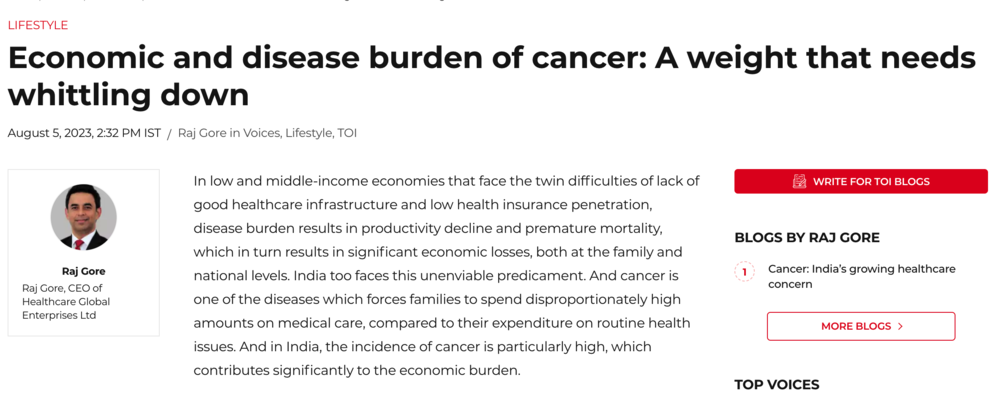
Economic and disease burden of cancer: A weight that needs whittling down
In low and middle-income economies that face the twin difficulties of lack of good healthcare infrastructure and low health insurance penetration, disease burden results in productivity decline and premature mortality, which in turn results in significant economic losses, both at the family and national levels. India too faces this unenviable predicament. And cancer is one of the diseases which forces families to spend disproportionately high amounts on medical care, compared to their expenditure on routine health issues. And in India, the incidence of cancer is particularly high, which contributes significantly to the economic burden.
The Federation of Indian Chambers of Commerce & Industry National Task Force on Cancer, estimations indicate that the economic cost, measured in GDP losses, reached approximately US$11 billion in 2020, which is equivalent to 0.4% of the national GDP. Going forward, by 2030, this burden is expected to increase to between US$36 billion and US$40 billion. This is primarily attributed to the projected growth in cancer-related mortality rates, although it is partially counterbalanced by improvements in the mortality-to-incidence ratio, as well as enhancements in life expectancy and GDP per capita.
Comprehensive Interventions for Addressing Challenges in Cancer Management
Given the current upward trend in cancer incidence and the sub-optimal quality of outcomes, it is crucial to address the challenges at hand and implement interventions across all stages of disease management. These interventions should focus on the following key areas:
- Awareness and Prevention: Efforts should be directed towards modifying exposure to risk factors associated with cancer development.
- Detection and Diagnosis: Ensuring early detection and accurate staging of the disease is vital for effective treatment outcomes.
- Treatment and Palliative Care: Adopting a multidisciplinary approach to treatment that emphasizes affordability, equitable access, quality of outcomes, and palliative care.
While the aforementioned strategies represent essential components for controlling cancer incidence and improving treatment outcomes, it is equally crucial to expand cancer registries and enhance health information systems. Collecting standardized and comprehensive data will provide the foundation for making informed and evidence-based policy decisions and conducting vital research.
The Escalating Financial Burden of Cancer Care: Rising Costs and Treatment Disparities
The financial burden associated with cancer care surpasses that of other diseases by a significant margin. Tobacco consumption, being the single biggest external risk factor contributing to the burden of cancer, necessitates the implementation of strict policies to reduce its consumption in the country. The cost of cancer treatment is exorbitant and nearly three times higher than the cost of treating other non-communicable diseases (NCDs). The expenses for a comprehensive initial treatment plan vary greatly depending on the affected organ and the stage at which cancer is detected. In the case of prevalent cancers such as breast, cervix, ovary, and gall bladder, the treatment expenses rise by 60% to 75% when comparing patients in Stage 1/2 to those in Stage 3/4 in mid-tier private hospitals. Moreover, the adoption of advanced therapies further amplifies the financial burden.
Nevertheless, the deepening penetration of health insurance across the length and breadth of the country, including in smaller towns, holds the potential to become a mitigating factor. Affordability measures are usually related to reducing investment and price points of treatments. But due to the progressive and recurrent nature of cancer, it is crucial to prioritize prevention, early detection, diagnosis and right treatment the first time which have a much bigger potential to reduce the financial burden over the lifetime of a patient.
- Prevention: There is a need to increase vaccination coverage as it can help prevent costly medical treatments, hospitalizations, and long-term complications associated with vaccine-preventable illnesses.
- Detection: Early detection of cancer can help avoid or mitigate the more expensive aspects of advanced cancer treatments.
- Diagnosis: Accurate and thorough diagnosis can effectively allocate necessary resources, prevent unnecessary treatments, reduce hospital readmissions, and avoid diagnostic errors, among other benefits.
- Treatment: Providing comprehensive and appropriate treatment from the beginning can enhance longevity and quality of life, while significantly reducing mortality and the overall cost of treatment over a patient's lifetime.
Ensuring Uniform Standards of Care and Comprehensive Coverage for Healthcare Programs
With approximately 54% of the population covered under some form of insurance or government-sponsored health coverage programs, it is imperative to ensure adequate coverage based on uniform standards of care. This will enable patients to receive the right treatment and ensure quality outcomes. However, significant variations in reimbursement among state governments and PMJAY schemes, ranging from 40% to 275% for select surgical and medical procedures, pose challenges. Additionally, key schemes do not cover essential diagnostic interventions and therapies such as PET-CT scans, biopsies, genomics, targeted therapy, and immunotherapy. Furthermore, a high percentage (25% to 30%) of expenses for patients covered under retail health insurance policies still remain out-of-pocket. Therefore, it is crucial to design comprehensive care plans based on uniform standards of care to address these gaps.
If appropriate action is not taken, the current challenges in cancer control in India are expected to worsen due to the intensification of risk factors and the ageing of the population. Estimates indicate that the reported cancer incidence will reach 250 to 280 cases per lakh population by 2030, up from 120 now, a significant increase.